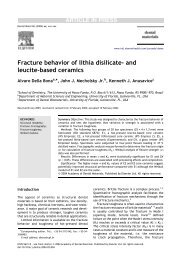Microleakage of various cementing agents for full cast crowns
Microleakage of various cementing agents for full cast crowns
Microleakage of various cementing agents for full cast crowns
Create successful ePaper yourself
Turn your PDF publications into a flip-book with our unique Google optimized e-Paper software.
<strong>Microleakage</strong> <strong>of</strong> <strong>various</strong> <strong>cementing</strong> <strong>agents</strong> <strong>for</strong> <strong>full</strong> <strong>cast</strong> <strong>crowns</strong> 451<br />
crown restorations bonded with zinc-phosphate<br />
cement remained functional despite microleakage<br />
<strong>for</strong> over 20 years, with none <strong>of</strong> the tooth–crown<br />
interfaces revealing carious lesions. Other authors<br />
concluded that the cement dissolving at the<br />
marginal gap does not seem to have any serious<br />
consequences and does not give rise to carious<br />
penetration [27,28].<br />
In the present study, microleakage occurred<br />
exclusively at the cement–enamel/dentin interface.<br />
This observation is confirmed by <strong>various</strong><br />
studies in vitro and in vivo [9,17,25,26,29,30].<br />
Although no microleakage occurred at the metal–<br />
cement interface, the use <strong>of</strong> metal primer should<br />
be taken into consideration clinically when metal<br />
restorations are cemented using polymer-based<br />
cements, because there is a chance <strong>of</strong> a better<br />
marginal seal when using metal primer [31,32].<br />
However, this effect is mainly dependent on the<br />
combination <strong>of</strong> alloy composition, metal surface<br />
treatment [33], metal primer, and the cement used<br />
[31,32].<br />
Our analysis <strong>of</strong> microleakage in enamel versus<br />
dentin revealed statistically significant differences<br />
in all study groups, i.e. the degree <strong>of</strong> microleakage<br />
was invariably higher with preparation margins in<br />
dentin than in enamel. This result is in keeping with<br />
the observations <strong>of</strong> other authors [8,9]. Although the<br />
retention mechanism on both dentin and enamel is<br />
micromechanical in nature, both substrates are<br />
dissimilar in composition and structure. The bond<br />
between the <strong>cementing</strong> agent and the dentinal hard<br />
tissue is compromised by the tubular microstructure,<br />
the higher content <strong>of</strong> organic material, and the<br />
intrinsic humidity <strong>of</strong> the dentinal substrate [34]. It<br />
must be noted, however, that bonding properties<br />
and tracer penetration may vary from location to<br />
location, depending on the structure and composition<br />
<strong>of</strong> the enamel or dentinal substrate. Major<br />
determinants include age, location, tissue health,<br />
and dietary factors [35,36].<br />
To be able to per<strong>for</strong>m an immediate relative<br />
comparison between the in vitro results <strong>of</strong> the study<br />
groups, margins were examined only after autopolymerization<br />
<strong>for</strong> all resin cements. One would have<br />
to take into consideration, however, that lightpolymerization<br />
increases the bond between dualcure<br />
resin cements and dental restorative materials<br />
[37]. Dual-cure resin cements should there<strong>for</strong>e be<br />
polymerized with a polymerizing light, especially if<br />
the crown margins are located supragingivally and<br />
are accessible.<br />
The mean results in terms <strong>of</strong> marginal gap on<br />
storing the specimens in water <strong>for</strong> 4 weeks and<br />
subjecting them to 5000 thermocycles were least<br />
favorable <strong>for</strong> one standard dual-cure resin<br />
cement (Panavia F) and <strong>for</strong> the self-adhesive<br />
resin cement (RelyX Unicem). On the other hand,<br />
the second-most favorable marginal gaps were<br />
also obtained with resin cement (RelyX ARC).<br />
Consequently, the marginal gap quality <strong>of</strong> a given<br />
type <strong>of</strong> <strong>cementing</strong> agent may be co-determined<br />
by its specific physicochemical properties. Gemalmez<br />
et al. [38] demonstrated that the marginal<br />
gap <strong>of</strong> porcelain inlays was larger when a dualcure<br />
resin cement was used <strong>for</strong> bonding. White<br />
and Kipnis [39], who investigated the effect <strong>of</strong><br />
five different luting <strong>agents</strong> on the marginal fit <strong>of</strong><br />
<strong>cast</strong> single-crown restorations bonded to<br />
extracted premolars in vitro, observed no significant<br />
marginal gap differences in the pre-bonding<br />
stage (range 35.1–69.5 mm), but reported that<br />
significant differences did emerge after cementation.<br />
The smallest gaps were observed with a<br />
glass–ionomer cement (Ketac-Cem; 3 M ESPE,<br />
Seefeld, Germany; 82.8G12.6 mm), the largest<br />
gaps with a micr<strong>of</strong>illed resin cement (Thin Film<br />
Cement; Den Mat Corp., Santa Maria, CA, USA)<br />
using oxalate dentin bonding (333.1G45.9 mm).<br />
This finding may conceivably be due to resin<br />
cements rapidly gaining viscosity in the process<br />
<strong>of</strong> curing. For this reason, White et al. [8]<br />
recommended that resin cements should be<br />
applied swiftly and care<strong>full</strong>y in clinical practice,<br />
and that indirect restorations should be inserted<br />
with considerable pressure.<br />
The present study also showed that bonding <strong>of</strong><br />
the restorations with the zinc-phosphate cement<br />
(Harvard cement), the conventional glass–ionomer<br />
cement (GC Fuji I), the resin-modified glass–<br />
ionomer cement (GC Fuji Plus), and one <strong>of</strong> the<br />
standard resin cements (RelyX ARC), involved no<br />
significant marginal gap differences. White et al.<br />
[29] demonstrated in vivo that the marginal gaps<br />
obtained with a zinc-phosphate cement (Flecks;<br />
Mizzy, Cherry Hill, NJ, USA) and a resin-modified<br />
glass–ionomer cement (Infinity; Den Mat Corp.,<br />
Santa Maria, CA, USA) with or without dentin<br />
bonding (Tenure; Den Mat Corp.) did not significantly<br />
differ after 6 months <strong>of</strong> clinical function. The<br />
clinical implications <strong>of</strong> marginal gaps—i.e. how<br />
large they have to be to favor penetration <strong>of</strong> toxins<br />
and bacteria, pulpal damage and secondary caries—<br />
remain to be clarified.<br />
The results obtained did not show any regular<br />
influence <strong>of</strong> marginal gaps on microleakage. One<br />
would have to assume that the quality <strong>of</strong> the<br />
marginal gap obtained under the experimental<br />
conditions outlined is not correlated with the<br />
microleakage results obtained. It should be pointed<br />
out that the results <strong>of</strong> the marginal gap were<br />
smaller than the maximum clinically acceptable
















